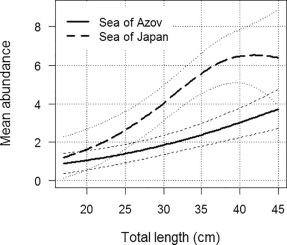International Journal for Parasitology ( IF 3.7 ) Pub Date : 2020-08-13 , DOI: 10.1016/j.ijpara.2020.06.008 Svitlana Shvydka 1 , Carmen Cadarso-Suárez 2 , Dominika Ballová 3 , Volodimir Sarabeev 4

|
One of the most intriguing questions in invasive biology is how an introduced species changes its population parameters in a new environment. Translocation of free-living species commonly results in co-introduction of their parasites. The current study focuses on the abundance pattern of the monogenean parasite Ligophorus llewellyni of the pacific so-iuy mullet, Planiliza haematocheila, across the native and introduced distribution ranges. We evaluated parasite release by the so-iuy mullet by comparing abundance patterns of L. llewellyni under effects of the host length, water temperature and month of the year in the Sea of Japan and the Sea of Azov. Generalised additive models applied to analysis of parasite abundance data showed that relationships between the mean number of L. llewellyni and the three tested independent variables were not linear. Our results suggest that the introduced host lost a large amount of parasite abundance due to the effect of warm climate in a new region, which is mediated by host defence mechanisms. The abundance of L. llewellyni rapidly rose in autumn, as fish activity and immune response decrease, reached the maximum in winter and began to fall in spring as a warm temperature facilitates the fish immune defence. The abundance of L. llewellyni showed an initial increase in response to fish growth and reached an asymptote. The response curves built for native and introduced regions reached an asymptote at different fish body lengths, reflecting the fish growth rate, which is higher in the introduced range of P. haematocheila. We found that the carried parasite species holds the same trend in relationships compared with its native area, between the mean number of monogeneans per host and independent variables increasing abundance with fish length, low temperature and cold months. Our results open new perspectives for future research on statistical modelling of parasite abundance across native and introduced distribution ranges in order to provide deeper insight into host-parasite interactions of invasive populations.
中文翻译:

Planiliza haematocheila (Teleostei: Mugilidae) 的本地和入侵种群中的单基因丰度模式:气候和宿主防御机制之间的相互作用解释了寄生虫的释放。
入侵生物学中最有趣的问题之一是引入的物种如何在新环境中改变其种群参数。自由生活物种的易位通常会导致其寄生虫的共同引入。目前的研究侧重于太平洋鲻鱼Planiliza haematocheila的单系寄生虫Ligophorus llewellyni在本地和外来分布范围内的丰度模式。我们通过比较L. llewellyni 的丰度模式来评估 so-iuy 鲻鱼的寄生虫释放在日本海和亚速海受寄主长度、水温和一年中月份的影响。应用于寄生虫丰度数据分析的广义加性模型表明,L. lewellyni的平均数量与三个测试的自变量之间的关系不是线性的。我们的研究结果表明,由于新地区温暖气候的影响,引入的宿主失去了大量的寄生虫丰度,这是由宿主防御机制介导的。L. lewellyni丰度在秋季迅速上升,鱼类活动和免疫反应下降,冬季达到最大值,春季开始下降,温暖的温度有利于鱼类的免疫防御。L. llewellyni的丰富度显示出对鱼类生长的响应的初始增加并达到渐近线。为原生和引入区域建立的响应曲线在不同鱼体长度下达到渐近线,反映了鱼类的生长速率,在P. haematocheila引入范围内较高。我们发现,携带的寄生虫物种与其原生地区相比,在每个宿主的平均单殖亚纲数量和自变量之间的关系中保持相同的趋势,随着鱼的长度、低温和寒冷的月份而增加丰度。我们的结果为未来对原生和引入分布范围内寄生虫丰度的统计建模的研究开辟了新的视角,以便更深入地了解入侵种群的宿主 - 寄生虫相互作用。











































 京公网安备 11010802027423号
京公网安备 11010802027423号